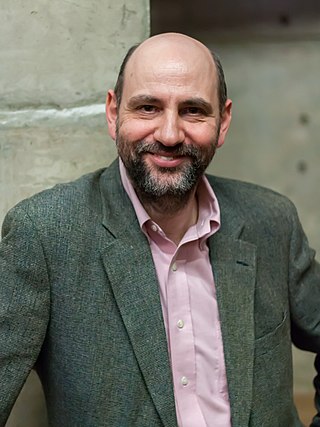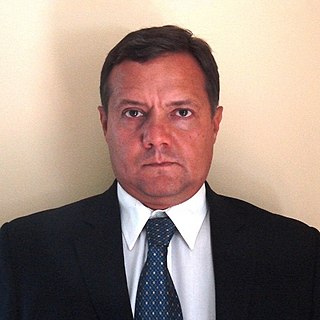
Kent Beck is an American software engineer and the creator of extreme programming, a software development methodology that eschews rigid formal specification for a collaborative and iterative design process. Beck was one of the 17 original signatories of the Agile Manifesto, the founding document for agile software development. Extreme and Agile methods are closely associated with Test-Driven Development (TDD), of which Beck is perhaps the leading proponent.

Martin Fowler is a British software developer, author and international public speaker on software development, specialising in object-oriented analysis and design, UML, patterns, and agile software development methodologies, including extreme programming.
In computer programming and software design, code refactoring is the process of restructuring existing computer code—changing the factoring—without changing its external behavior. Refactoring is intended to improve the design, structure, and/or implementation of the software, while preserving its functionality. Potential advantages of refactoring may include improved code readability and reduced complexity; these can improve the source code's maintainability and create a simpler, cleaner, or more expressive internal architecture or object model to improve extensibility. Another potential goal for refactoring is improved performance; software engineers face an ongoing challenge to write programs that perform faster or use less memory.
In software engineering, a design pattern describes a relatively small, well-defined aspect of a computer program in terms of how to write the code.
Agile software development is the mindset for developing software that derives from values agreed upon by The Agile Alliance, a group of 17 software practitioners in 2001. As documented in their Manifesto for Agile Software Development the practitioners value:
In agile principles, timeboxing allocates a maximum unit of time to an activity, called a timebox, within which a planned activity takes place. It is used by agile principles-based project management approaches and for personal time management.
Software craftsmanship is an approach to software development that emphasizes the coding skills of the software developers. It is a response by software developers to the perceived ills of the mainstream software industry, including the prioritization of financial concerns over developer accountability.

Dave Thomas is a computer programmer, author and editor. He has written about Ruby and together with Andy Hunt, he co-authored The Pragmatic Programmer and runs The Pragmatic Bookshelf publishing company. Thomas moved to the United States from England in 1994 and lives north of Dallas, Texas.
James A. Highsmith III is an American software engineer and author of books in the field of software development methodology. He is the creator of Adaptive Software Development, described in his 1999 book "Adaptive Software Development", and winner of the 2000 Jolt Award, and the Stevens Award in 2005. Highsmith was one of the 17 original signatories of the Agile Manifesto, the founding document for agile software development.

Andy Hunt is an author on software development. Hunt co-authored The Pragmatic Programmer, ten other books and many articles, and was one of the 17 original authors of the Agile Manifesto. He and partner Dave Thomas founded the Pragmatic Bookshelf series of books for software developers. He also plays the trumpet, flugel horn, and keyboards and produces music at Strange & Special Air Productions.
DevOps is a methodology in the software development and IT industry. Used as a set of practices and tools, DevOps integrates and automates the work of software development (Dev) and IT operations (Ops) as a means for improving and shortening the systems development life cycle. DevOps is complementary to agile software development; several DevOps aspects came from the agile way of working.
Neville Roy Singham is an American businessman and social activist. He is the founder and former chairman of Thoughtworks, an IT consulting company that provides custom software, software tools, and consulting services, which he sold to a private equity firm for $785 million in 2017.
Continuous delivery (CD) is a software engineering approach in which teams produce software in short cycles, ensuring that the software can be reliably released at any time and following a pipeline through a "production-like environment", without doing so manually. It aims at building, testing, and releasing software with greater speed and frequency. The approach helps reduce the cost, time, and risk of delivering changes by allowing for more incremental updates to applications in production. A straightforward and repeatable deployment process is important for continuous delivery.
A unit of work is a behavioral pattern in software development. Martin Fowler has defined it as everything one does during a business transaction which can affect the database. When the unit of work is finished, it will provide everything that needs to be done to change the database as a result of the work.

Extreme programming (XP) is a software development methodology intended to improve software quality and responsiveness to changing customer requirements. As a type of agile software development, it advocates frequent releases in short development cycles, intended to improve productivity and introduce checkpoints at which new customer requirements can be adopted.
In software engineering, a microservice architecture is a variant of the service-oriented architecture structural style. It is an architectural pattern that arranges an application as a collection of loosely coupled, fine-grained services, communicating through lightweight protocols. One of its goals is that teams can develop and deploy their services independently of others. This is achieved by the reduction of several dependencies in the code base, allowing developers to evolve their services with limited restrictions from users, and for additional complexity to be hidden from users. As a consequence, organizations are able to develop software with fast growth and size, as well as use off-the-shelf services more easily. Communication requirements are reduced. These benefits come at a cost to maintaining the decoupling. Interfaces need to be designed carefully and treated as a public API. One technique that is used is having multiple interfaces on the same service, or multiple versions of the same service, so as to not disrupt existing users of the code.

Robert Cecil Martin, colloquially called "Uncle Bob", is an American software engineer, instructor, and author. He is most recognized for promoting many software design principles and for being an author and signatory of the influential Agile Manifesto.

Miguel "Mike" Beedle was an American software engineer and theoretical physicist who was a co-author of the Agile Manifesto.

CodeScene is a behavioral code analysis tool developed by Empear AB. CodeScene provides code visualizations based on version-control data and machine learning algorithms that identify social patterns and hidden risks in code.
Data mesh is a sociotechnical approach to building a decentralized data architecture by leveraging a domain-oriented, self-serve design, and borrows Eric Evans’ theory of domain-driven design and Manuel Pais’ and Matthew Skelton’s theory of team topologies. Data mesh mainly concerns itself with the data itself, taking the data lake and the pipelines as a secondary concern. The main proposition is scaling analytical data by domain-oriented decentralization. With data mesh, the responsibility for analytical data is shifted from the central data team to the domain teams, supported by a data platform team that provides a domain-agnostic data platform. This enables a decrease in data disorder or the existence of isolated data silos, due to the presence of a centralized system that ensures the consistent sharing of fundamental principles across various nodes within the data mesh and allows for the sharing of data across different areas.







